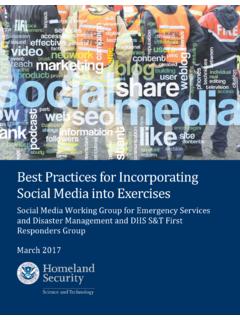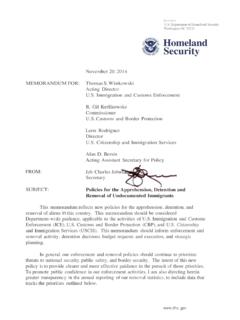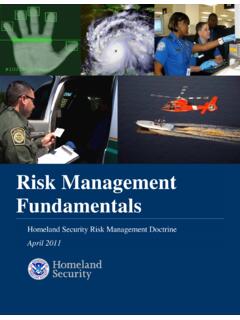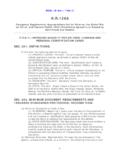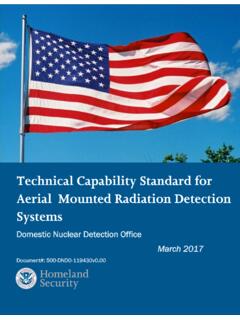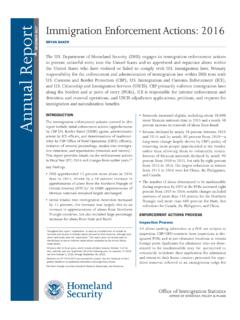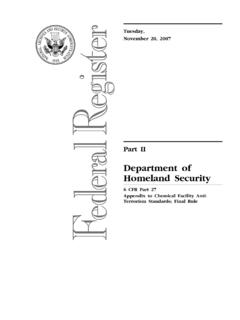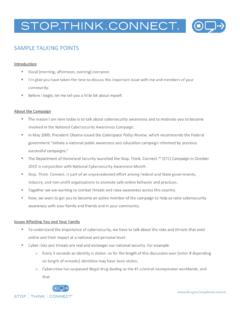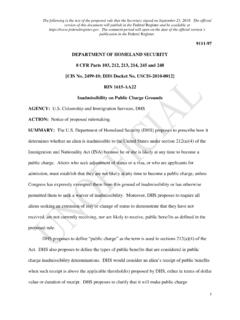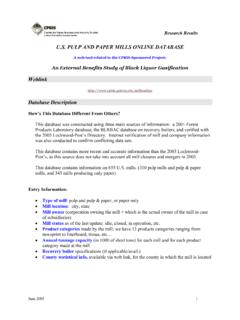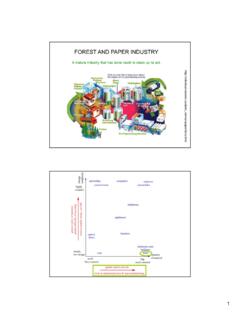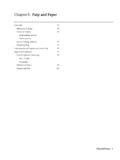Transcription of Protect your Pulp and Paper Production Chemicals from Use ...
1 March 2018 Protect Your pulp and Paper Production Chemicals from Use in a Terrorist Attack From books and currency, to Paper towels and food wrappers, Paper and Paper products are indispensable to our modern way of life. T he pulp and Paper industry that manufactures these essential Paper products uses a variety of Chemicals throughout the manufacturing process. When used properly, these Chemicals assist in the Production of the Paper and Paper products we use every day. In the wrong hands, however, terrorists can also use some of these Chemicals to do great harm. pulp and Paper facility. (Source: Paper industry World) What is CFATS? The Chemical Facility Anti-Terrorism Standards (CFATS) program focuses precisely on filling this chemical security gap.
2 Authorized by Congress in 2006, the CFATS program identifies and regulates facilities that possess specific high-risk Chemicals at certain quantities and concentrations known as Chemicals of interest (COI) to ensure they have security measures in place that reduce the risks associated with the COI. Appendix A of the CFATS regulation lists more than 300 COI and their respective screening threshold quantity (STQ), concentration, and security issues for which they are regulated. Any facility including a pulp , Paper , or Paper conversion facility that meets or exceeds the STQ for any COI must report those Chemicals to the Department of Homeland Security (DHS) through an online survey called a Top-Screen.
3 Regulated pulp and Paper facilities may include but are not limited to pulp mills, Paper mills, paperboard mills, newsprint mills, specialty Paper manufacturing, and a variety of converted Paper facilities. Chemicals Commonly Found in CFATS-Regulated pulp and Paper Facilities pulp , Paper , and Paper conversion facilities use a wide variety of Chemicals , many of which are regulated by CFATS for various security issues. DHS has identified these COI based on the belief that these Chemicals if released, stolen or diverted, and/or used as a contaminant have the potential to create significant human life and/or health consequences. Some of the commonly reported COI among pulp and Paper facilities include, but are not limited to: Aluminum (powder) Ammonia (anhydrous) Ammonia (conc.)
4 Of 20% or greater) Chlorine Chlorine dioxide Cyclohexylamine Hydrogen peroxide (conc. of at least 35%) Hydrogen sulfide Methane Nitric acid Potassium permanganate Propane Sodium chlorate Sodium hydrosulfite Sodium nitrate Sulfur dioxide (anhydrous) Triethanolamine pulp and Paper facilities may possess many different Chemicals depending on the Paper or Paper product manufactured at the facility, so it is important to become familiar with all 300+ COI listed in Appendix A of the CFATS regulation, along with the Chemicals STQs, concentrations, and security issues for which it is regulated. Information on Appendix A may be found by visiting CFATS Exclusions Facilities regulated as a Public Water System under the Safe Drinking Water Act, Treatment Works under the Federal Water Pollution Control Act, and/or by the United States Coast Guard under the Maritime Transportation Security Act (MTSA) are excluded from the CFATS program.
5 Facilities where the Nuclear Regulatory Commission (NRC) regulates a majority of the facility for radioactive material are also excluded. In addition, any facilities owned or operated by the Department of Defense or Energy are also excluded. Please see 6 CFR (b) for more information. pulp and Paper facilities in which the Environmental Protection Agency (EPA) regulates wastewater (effluence) treatment at the facility are required to comply with CFATS. What s Next? If your facility is not exempt from filing a Top-Screen based on one of the categories listed above, and it possesses any COI at or above the STQ and concentration listed in Appendix A, your next steps include the following: Register for a Chemical Security Assessment Tool (CSAT) account, at Fill out a Top-Screen, an easy-to-use online survey facilities use to report their chemical holdings and facility information to DHS.
6 Based on the information provided in the Top-Screen, DHS assesses the overall risk of the facility. Facilities assessed as high risk by DHS are required to submit a Security Vulnerability Assessment/Site Security Plan tailored to the risks associated with their chemical holdings. More than 150 DHS Chemical Security Inspectors are located nationwide to assist high-risk facilities identify and implement security measures, and conduct inspections to ensure compliance with the CFATS regulation. Failure of a Chemical Facility to Submit a Top-Screen DHS has the authority to issue an order assessing a civil monetary penalty to a facility that is in possession of reportable COI and fails to submit a Top-Screen or is found to be in violation of any aspect of the CFATS program.
7 For more information, please visit Tools and Resources for pulp and Paper Facilities DHS is committed to providing CFATS resources and tools to facilities with COI. Get the Appendix A Chemicals of interest (COI) List: Review the CFATS Penalty Policy: Request a CFATS presentation to learn about any part of the CFATS regulation from submitting a Top-Screen to editing a security plan: Request a Compliance Assistance Visit to learn what to expect from a CFATS Authorization or Compliance Inspection: The CFATS Knowledge Center is an online repository of frequently asked questions (FAQs), articles, and more: The CSAT Help Desk provides timely support to chemical facility owners and operators.
8 Call 1- 866-323-2957 or email Contact Information For any questions, comments, or concerns, please contact or visit March 2018
